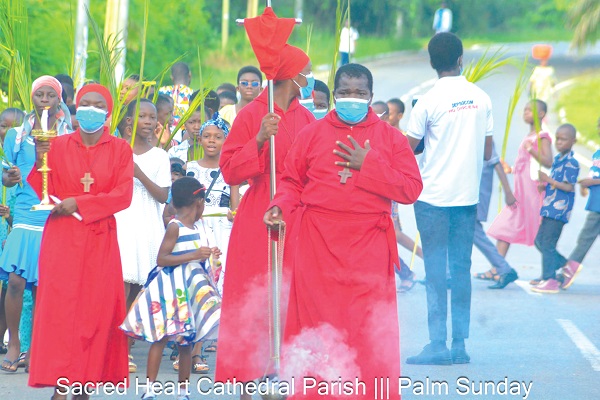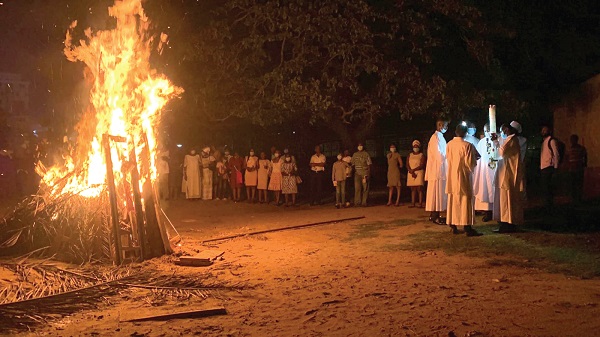
Celebrating Easter the Catholic way
While Easter is typically celebrated with a plethora of joyful activities from Good Friday through Easter Sunday, Catholics take a different approach and begin a 40-day spiritual journey in preparation for the holiday.
Advertisement
Easter is a significant feast on the church's liturgical calendar for the Catholic community, and it is observed with all the decorum and a line-up of serious spiritual exercises.
The church officially starts its solemn journey of prayer and fasting on Ash Wednesday, a day observed as a holy one for solemn reflection and the application of ashes on the foreheads of parishioners to symbolise their human and sinful nature.
This allows Catholics to be solemn and reflect for the following six weeks of penitence (repentance) known as the Lenten season or Lent.
It is common to see Catholics in a solemn mood during these times of penitence and preparation, as the church mandates that the Catholic faithful pray more, give alms, occasionally go for confession, exhibit acts of humility, forego eating meat every Friday as well as begin a journey of fasting and prayer.
While Catholics observe penitence with all seriousness during this 40-day journey, the church lays major emphasis on the Holy Week, within which the faithful are strictly obliged to partake in the week-long activities.
This includes attending the Chrism Mass where holy oils for sacraments are blessed and concentrated, observing Holy Thursday and joining the Friday Stations of the Cross meditation to show great reverence to Christ.
Holy Week
The Holy Week - sometimes referred to as Passion Week, begins with Palm Sunday, which is the commemoration of the triumphant entry of Jesus into Jerusalem to begin His passion, until Easter Sunday.
Other Trending Stories
Catholics are required to completely participate during this solemn time.
During this week, significant days and events are marked to highlight the intense impact of the Easter period, including celebrating the Chrism Mass, which is typically marked on any day within the Holy Week before Holy Thursday (usually celebrated on Wednesday in Ghana).
The night when priests and some church leaders perform an act of foot washing to symbolise Christ's humility is observed on Holy Thursday, also known as Maundy Thursday, by the church.
This day also commemorates Jesus' establishment of the Eucharist (the Holy Communion rites).
Catholics participate in the Stations of the Cross while carrying a crucifix and meditating on Christ's suffering on Good Friday, which is frequently regarded as one of the most solemn days of the Holy Week.
In the afternoon, beginning at 2:30 p.m. with the Divine Mercy Novena (a prayer), they continue with the Veneration (prayer and adoration) of the Cross at 3 p.m. which is very significant, depicting the time that Jesus gave up his spirit.
On this day the Bible readings recall the passion and death of Jesus and Catholics are obliged to show great reverence.
The iconic bonfire

The lighting of a pile of wood into a bonfire on the eve of Easter Sunday is one of the well-known, long-standing traditions that define the Easter celebration.
While the fire is lit and blessed by the priest, the congregants also light their candles and offer prayers.
The day is observed to commemorate the resurrection of Jesus Christ.
The priest then joins the congregants to process to the chapel.
At the chapel, the priest stands at the Ambo (a large pulpit or reading desk), sings the Easter proclamation or what is often referred to as the Exsultet by Catholics and the faithful join in the proclamation by responding “Amen” at the end.
Advertisement
During this night they have the longest of the Liturgy of the Word.
There are nine readings, seven from the Old Testament and two from the New Testament.
On Sunday, the church decorates its interior with white while the faithful also wear white apparel to symbolise the joy that comes with Christ's resurrection.
Significance
A Catholic priest in the Donkorkrom Apostolic Vicariate in the Eastern Region, Rev. Fr Stephen Kofi Sakpaku, in a conversation with the Daily Graphic on how Catholics celebrate Easter, revealed that the purpose of the church's solemn religious observances is to connect with the true significance of the celebration.
Advertisement
When asked why the church gives the Easter celebration such prominence and considers it to be one of the most important feasts on the church's liturgical calendar, he explained that the significance attached to the celebration represents the birth of the Catholic Church and helps solidify the faith of Catholics.
“The Holy Week as a whole and the resurrection of Jesus help us understand how our faith should be about putting aside our doubts and trusting that, because of his love for us and through Jesus, the light of the world, we are not broken in his sight.
It commemorates both the anticipation of His [Jesus'] death and the joy of the Lord's return.
We can assess our faith internally during Lent and get ready for what the meaning of Jesus' return will be,” he said.
Advertisement




